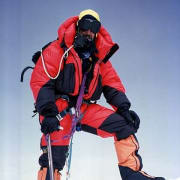The World's Epochal Fourteen 8,000-Meter Peaks

The World's 'Eight-Thousanders'
Climbing the ‘eight-thousanders’ constitutes the ultimate achievement in mountaineering. Fourteen mountains in the world rise above 8,000-meters (26,247 feet). The International Mountaineering and Climbing Federation (“UIAA”) recognizes only these peaks as meeting the 8,000-meter requirement, as ‘sufficiently independent of neighboring peaks’. All 14 of the 8,000-meter peaks reside in the Himalayan and Karakorum mountain ranges in Asia, and reach into the rarefied and dangerous strata known as the ‘Death Zone’. Legendary Italian climber, Reinhold Messner, became the first person to scale all of these prestigious mountains in 1986 without the aid of supplemental oxygen. His historic feat, chased by ambitious mountaineers ever since, set the high-water mark in mountaineering success.
The exact number of certified and recognized members of the elite eight-thousanders club remains unclear. While estimated at 40-50 members, a team of experts concluded in 2022 that, with evidence, only three climbers have stood on the true geographic summit of all 14 8,000-meter peaks – Ed Viesturs, Veikka Gustafsson and Nirmal Purja. Beyond that study, most believe that Edurne Pasaban from Spain became the first woman to climb all fourteen mountains in 2010 with the use of supplemental oxygen, while Gerlinde Kaltenbrunner became the first woman to do so without such oxygen assistance in 2011. The 'evidence' debate continues on how many climbers have achieved this milestone, though the likely number stands at approximately 45 mountaineers.
The journey to the summits of these vaulted peaks often presents deadly consequences. On Annapurna one climber attempting the summit dies for every three that make it to the top – making it the deadliest of the group. K2 and Nanga Parbat follow with one death for every four summiteers, and Dhaulagiri and Kangchenjunga account for one death for every six successful climbers. Regardless of danger and statistics, mountaineers still flock to these iconic peaks scattered across the Himalaya and Karakoram mountain ranges, which present arguably the most formidable challenges in mountaineering. These peaks test the limits of human capacity, exposing climbers to the most extreme conditions in the world. The eight-thousanders in order by height:
The 14 8,000-Meter Peaks
Mount Everest (8,848m / 29,029 feet): The highest peak on Earth, located on the Nepal-Tibet border and known for its record height has two main climbing routes: the Southeast Ridge and the North Ridge. Everest's allure draws countless climbers seeking to touch the top of the world. K2 (8,611m / 28,251 feet): Known as the "Savage Mountain," K2, the world’s second-highest peak is located on the Pakistan-China border in the Karakoram range. It is famed for its technical difficulty and perilous Bottleneck section where numerous climbers have perished. Kangchenjunga (8,586m / 28,169 feet): The third-highest peak, located between Nepal and India, remains sacred to the local population. Its steep ridges and frequent avalanches pose significant dangers. Climbers often stop short of the true summit to honor the local beliefs. Lhotse (8,516m / 27,940 feet): Sharing much of its climbing route with Everest up to the South Col, Lhotse is the fourth-highest mountain. Its main peak is known for its massive, icy south face - one of the world's most imposing walls. Makalu (8,485m / 27,840 feet): This pyramid-shaped peak is one of the most difficult eight-thousanders, located close to Everest. The final ascent involves sharp ridges and exposed climbing, testing the skills of the most elite climbers. Cho Oyu (8,188m / 26,867 feet): The sixth-highest mountain, located on the Nepal-Tibet border, is considered one of the "easier" eight-thousanders due to its less technical standard route. It serves as a popular training peak for climbers preparing for Everest. Dhaulagiri (8,167m / 26,795 feet): Entirely located in Nepal, Dhaulagiri is known for its impressive mass and difficult routes. The mountain’s remote location and frequent avalanches make it a daunting challenge. Manaslu (8,163m / 26,781 feet): The "Mountain of the Spirit," located in Nepal, has gained popularity in recent years as an introduction to 8,000-meter climbs. However, its slopes are avalanche-prone, and weather conditions can change rapidly. Nanga Parbat (8,126m / 26,660 feet): Dubbed the "Killer Mountain," Nanga Parbat is infamous for its high fatality rate and difficult ascent. Located in Pakistan, it features the dramatic Rupal Face, the tallest mountain face in the world. Annapurna (8,091m / 26,545 feet): Known for being the deadliest eight-thousander, Annapurna's routes are highly avalanche-prone. The mountain's fatality-to-summit ratio has made it one of the most feared climbs in mountaineering.
Gasherbrum I (8,080m / 26,509 feet): Also called Hidden Peak, it lies in the Karakoram range. It’s known for its isolation and stunning beauty, with technically demanding routes and extreme weather challenges. Broad Peak (8,051m / 26,414 feet): Near K2, Broad Peak is named for its extensive summit ridge. Although not as technically demanding as K2, it still poses serious challenges, particularly on the final sections where weather conditions can be severe. Gasherbrum II (8,035m / 26,362 feet): Another peak in the Karakoram, Gasherbrum II is one of the more frequently climbed eight-thousanders but remains demanding due to severe weather and complex glacial routes. Shishapangma (8,027m / 26,335 feet): The lowest of the 14 8,000-meter peaks, Shishapangma is entirely in Tibet. The mountain is often approached via a relatively less technical north route, though summit conditions can still be unpredictable and harsh.
